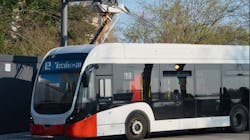TransLink’s Board of Directors and the Mayors’ Council approved the Transport 2050: 10-Year Priorities plan, becoming the region’s new decade-long list of transportation priorities for Metro Vancouver.
This plan prioritizes the first 10 years of actions originally outlined in Transport 2050.
TransLink will implement an unprecedented increase in local bus service and continue expanding the SkyTrain network, while also introducing Bus Rapid Transit (BRT) technology to the region. BRT will bring specialized zero-emission buses to fully traffic-separated corridors with dedicated stations for passengers to board.
“This plan outlines the biggest transportation improvements in Metro Vancouver’s history. It will require a new approach to how we fund, build and operate our regional transportation system, requiring all governments – local, regional, provincial and federal – to work together in innovative ways to achieve this vision,” said Jonathan Coté, chair, Mayors’ Council on Regional Transportation. “Through collaboration, this much-needed plan will increase access to green transportation options that reduce costs and GHG emissions, help address our region’s housing affordability crisis and better connect our communities.”
Major priorities include:
- Up to nine new traffic-separated BRT lines.
- More than doubling bus service over 2022 levels.
- Building the Burnaby Mountain Gondola to Simon Fraser University.
- Extending the Millennium Line from Arbutus to the University of British Columbia.
- Increasing HandyDART service by 60 percent and providing 24-hour service.
- Immediately advancing a business case to determine the best rapid transit technology on the Metrotown to Park Royal corridor, while delivering better bus service in the short term.
- Exploring other potential SkyTrain extensions, including to Newton in Surrey and to Port Coquitlam.
- Building 450 kilometers (280 miles) of new traffic-separated cycling paths including bike networks in every Metro Vancouver Urban Center.
- Introducing 200 new bike lockers and six new bike parkades.
- Increasing SeaBus service start and end times to match SkyTrain’s service hours.
Transport 2050: 10-Year Priorities received overwhelming public support in late April, with 85 percent of respondents providing positive feedback about the proposal’s transit improvements during the public engagement period.
“We are at a critical time to invest in our future. We have heard through the most robust community engagement in TransLink’s history that we need to act with both ambition and urgency. Transport 2050: 10-Year Priorities will bring historic actions to combat climate change, reduce congestion, and improve livability in this region,” said TransLink CEO Kevin Quinn.
Transport 2050: 10-Year Priorities is estimated to cost C$21 billion (US$16 billion) over 10 years and will need significant new revenue sources and investments from all levels of government to deliver. It will be delivered in phases and funded through a series of future investment plans.
BRT facts:
- BRT is a traffic-separated rapid transit service with signal priority at intersections.
- Stations will allow for fast and convenient boardings like SkyTrain.
- BRT will have specialized zero-emission vehicles with spacious interiors.
- BRT costs a fraction of the cost of SkyTrain per kilometer.
- Once work commences, BRT lines can be implemented in under five years.
- The corridors planned to receive BRT include:
- Hastings St (upgrade from R5)
- King George Blvd (Surrey to White Rock)
- Langley – Haney Place (200 St - Golden Ears - Lougheed Hwy)
- Lougheed Hwy (upgrade from R3)
- Lynn Valley – Downtown/Lonsdale (Lions Gate Bridge)
- Marine Dr Station – 22nd St Station (Marine Way)
- Metrotown – Park Royal (Second Narrows)
- Richmond Centre – Metrotown (Knight St Bridge)
- Scott Road (upgrade from R6)
The next step is for TransLink to develop a detailed municipal partnership framework to engage local communities in future BRT planning decisions.



